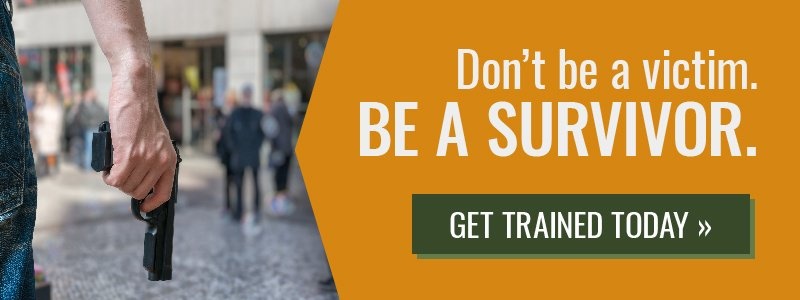 A lot of employers are trying figure out if advanced security is an effective way to protect their employees from workplace violence. Putting your entire workforce through an active shooter response training course seems a little too intense. It's not something employers want to even think about, much less ask their employees to participate in.
A lot of employers are trying figure out if advanced security is an effective way to protect their employees from workplace violence. Putting your entire workforce through an active shooter response training course seems a little too intense. It's not something employers want to even think about, much less ask their employees to participate in.
Security precautions seem like a much less invasive solution that would accomplish the same purpose: to keep violence out of your workplace. However, there is a difference between making your workplace secure, and training your workplace for safety. Simply put...
- Security reduces risk of emergency.
- Training responds in an emergency.
All of the security guards, metal detectors, outdoor cameras, and key codes for building entrances cannot beat the effectiveness of first response training. Why? Because security measures ward off potentially violent encounters, but if and when security is breached, your company needs a trained response plan.
Security is good and necessary, but in-depth workplace violence prevention training is essential. Let's look at the unique advantages workplace safety training has over workplace security.
Identify and Report Concerning Behaviors
Security guards, whether armed or unarmed, are trained for access control and building checks. If they notice concerning behaviors or conflict, they are not expected to intervene; they are simply expected to report it.
In all reality, security guards are unlikely to be the first to notice odd behaviors in a corporate building because they don't have enough interaction with employees throughout the workweek to recognize concerning behaviors before they become an obvious threat.
Your employees are your first line of defense in proactively identifying and reporting concerning behaviors. If an employee is acting odd or out of character, their team members will notice long before a security guard would. Proper training instructs employees on how to spot abnormalities in their coworkers' behavior, and also guides organizations in establishing a process for reporting and addressing those behaviors.
The sooner concerning behavior is reported, the more opportunity your organization will have to address it effectively. Sometimes a conversation with HR is sufficient; other times, professional counseling is necessary. It's important that your organization has a plan and a process for getting your employees the help they need as soon as you're aware of a problem.
De-escalate Situations
Workplace violence is not always premeditated. Sometimes it happens when a minor argument or misunderstanding escalates dramatically. With proper training, your employees can learn to realize when a situation is escalating — even when they're in the middle of it — and then respond in a way that will de-escalate the situation before it reaches threatening levels.
Strategize for Survival
If your office utilizes advanced security systems, it's important to realize that security in the form of technology is only capable of doing what it is programmed to do. It's incapable of thoughtful problem solving or accounting for unexpected events. Instead, it does precisely what it was designed to do — and nothing more.
On most days, that's sufficient, but as soon as there is an active shooter event at your office or some other type of workplace violence, technology's capabilities become obsolete. The outcome of the situation is largely in the hands of your employees, who have the power to think strategically.
Strategic and empowered thinking is a key part of workplace violence prevention training. If you're ever in a situation where workplace violence is life-threatening, it's important to never assume the role of a victim. You must adopt a survival mentality, which empowers you to think quickly and respond effectively. A survival mentality is not something most people can turn on like a switch, but it is something that can be trained. Hands-on, scenario-based training gives you the opportunity to practice survival techniques and strategies so that if you're ever in a situation where you need them, you'll know what to do.
Delegate Action
Everyone — even individuals who have undergone workplace violence training — will react differently in an emergency. Some will respond exactly as they were trained, and others will panic or freeze up. The best workplace violence prevention training will not only prepare you to delegate tasks to colleagues who may not be as quick to respond, but it will help you know what tasks to delegate. Giving your panicked employee a job to do that's actually necessary, such as pushing the conference table in front of the door, will snap them back to reality and allow them to focus their energy on executing a survival plan.
Provide Medical Care
Emergency medical care is not something most organizations teach in active active shooter response courses or workplace violence prevention training. However, at ProActive Response Group, we believe this is one of the most important aspects of our training.
If your coworker is injured and critically bleeding, you need to know how to apply a tourniquet or a pressure dressing in order to stop the bleeding until EMS arrives. This level of medical training is know as emergency casualty care, and it takes your skills far beyond basic first aid.
Interact with First Responders
It may surprise you that there is a level of training involved in interacting with professional first responders. Law enforcement's primary responsibility is to locate and stop the individual inflicting violence. Your role is not to ask them for help in treating injured colleagues. You can best help them by telling them where the shooter is (if you know), and then getting out of their way.
Training and Security Work Best Together.
In closing, we want to point out that using security and training together is ideal. Security itself is insufficient, but just because you have provided your team with workplace violence prevention training doesn't mean you don't need proper security at your organization. Security is one layer of defense, but nothing is as valuable as training that can be used in a multitude of unpredictable situations to save lives. Contact us today to schedule workplace violence prevention training for your company!
.png?width=499&height=133&name=Logo-menu%20(1).png)



